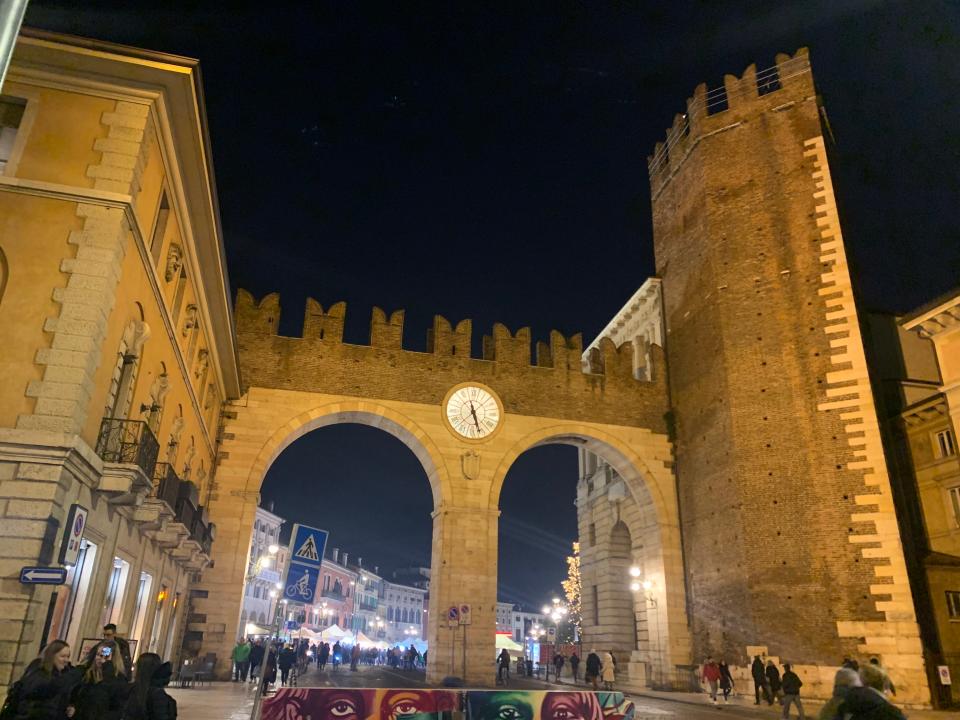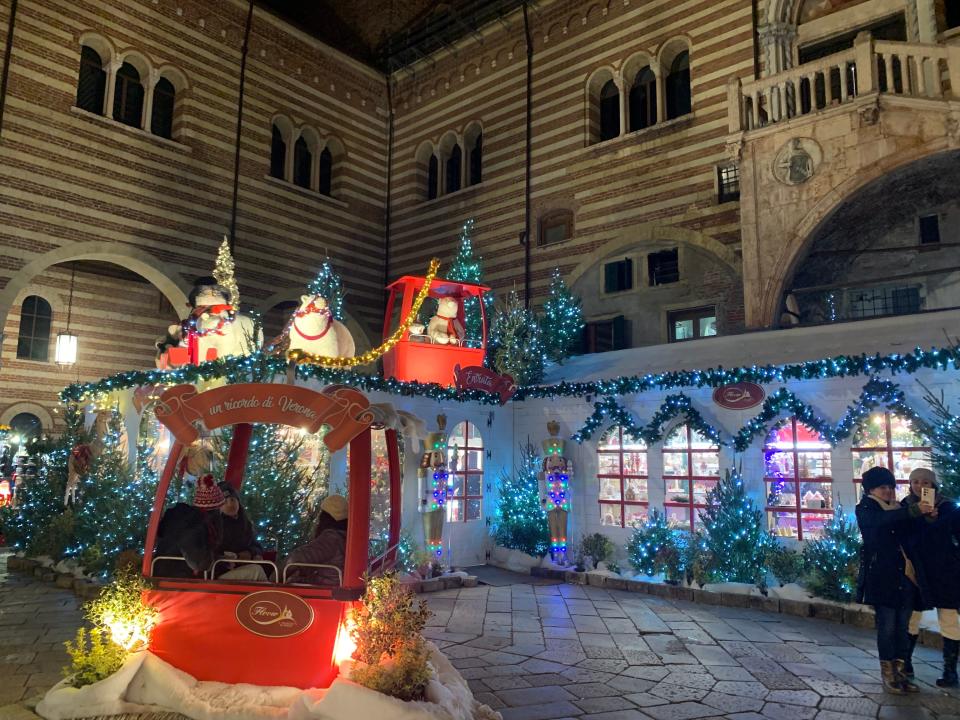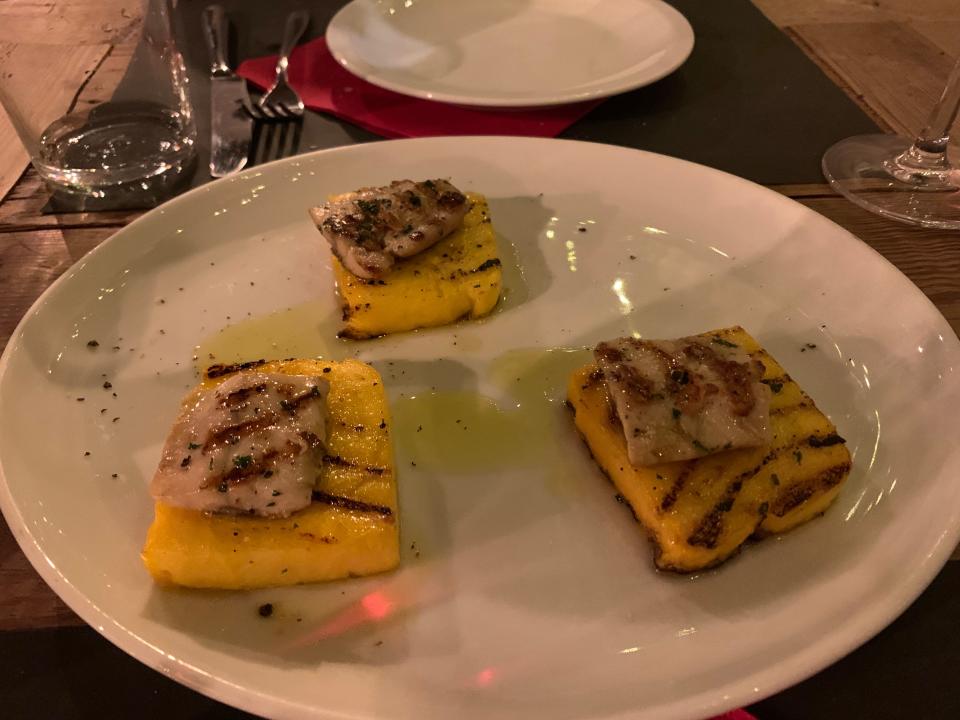I spent a week in Northern Italy outside of busy season. I loved the smaller crowds, half-priced hotels, and crisp weather.

My boyfriend and I took a trip in December to Northern Italy.
We found fewer crowds and cheaper prices, which helped us get more out of every day there.
The decorations and festive spirit of the holiday season also added something special to the trip.
In December, I flew with my boyfriend to meet his family in Germany.
It was our first time traveling together internationally, and we decided to spend five days in Italy, just a few hours from his family's home in Southern Germany.
Since Italy is swarming with tourists in summer and early fall, I was excited to travel in the winter, when it's less busy and less expensive.
Our train ride from Innsbruck, Austria, to Verona took just over three hours.

The train was fairly packed, but we found seats together without reserving them in advance.
We traveled through snowy mountains and tunnels, the Dolomites, and the picturesque Italian countryside. Around 5:30 p.m., we arrived at the Verona train station and headed out into the dark city.
We had a 20-minute walk from the train station to our hotel, where we passed a huge Christmas tree and bustling Christmas market.
Our accommodations were in the middle of the city and much cheaper than I'd expected.

Although we only booked about a week in advance, we found a small hotel company offering apartments in the middle of the city for just a few hundred dollars for the week.
We stayed in a studio apartment with a small balcony that cost us just under $400 for four nights. In September, one of the most expensive months to visit Verona, the same stay costs about $850.
We were within walking distance of everything we wanted to see in the city and less than two blocks from the city's famous arena.
Later, we wandered to Piazza Erbe, a lovely old square just a few minutes’ walk from our hotel.

Piazza Erbe's cobblestone streets were lit up by festive light displays, and we spent nearly an hour exploring the winding Christmas markets.
Each archway seemed to lead to a new cluster of stalls, selling cheeses, meats, wooden crafts, and ornaments.
The air was crisp but not unpleasant, with the temperature hovering in the high 40s Fahrenheit.
We had no solid plan for dinner that night, but easily found a place with no wait.

We got a somewhat early dinner since we'd skipped lunch, and finding a restaurant was easy.
Only one other group was at the eatery when we arrived, and tables slowly filled up later in the night.
The chef was cooking just a few feet from our table, and they checked in on us several times. We ordered two pastas and a rabbit with polenta, all washed down with a local red wine.
At the end of the meal, the chef even sent us free shots of grappa (a grape-based spirit). Everything was delicious.
We spent the next day exploring Verona in the daylight.

Verona is a midsize Italian city perhaps best known for being the setting of William Shakespeare's "Romeo and Juliet."
We visited Juliet's house, filled with artifacts and art from the play's history. We even stepped outside onto Juliet's famous balcony.
There was no wait to get inside the house — another perk of not visiting during busy season.
We toured all four of the city's main famous churches.

We paid a few euros for all-day entry to all of the churches and basilicas in the city, all within walking distance.
There were very few other tourists around. Once again, we waited in no lines.
With no crowds, it was easy to move quickly between all the sites we’d wanted to see.

We spent the day exploring the city on foot and we didn't encounter many crowds at all.
Verona also has a beautiful river, and we enjoyed crossing back and forth over bridges several times during the day.
We got to see the city from above, too.

For a few euros, we rode up the funicular to arrive on the top of a mountain with great views of the city and surrounding Italian countryside.
The car was small, with room for only a handful of people, but we only had to wait the length of the ride down the mountain, around five minutes.
We quickly stopped back in our hotel to get changed and headed to dinner.

We ate at a restaurant called Trattoria de Camillo, where the owner was also our server. Once again, we didn't wait for a table.
He warmly welcomed us and even took the time to pull a chair over to our table to explain the menu, which was written in Italian on a chalkboard, to us.
We took a lot of his suggestions, opting for seasonal and local specialties, like sardines on polenta as an appetizer and huge plates of pumpkin risotto.
The next day, we headed out into the wet, foggy morning to catch our train to Milan.

It was lightly raining as we walked from the train station through the Indro Montanelli Gardens.
Eventually, we got to Quadrilatero della moda, Milan's famous fashion district. We wound our way slowly up and down the streets packed with designer stores.
Next, we saw the Galleria Vittorio Emanuele II, a large, semi-outdoor shopping mall with high, beautiful ceilings next to the Duomo.
We also saw the Duomo — and, once again, we didn't wait long to do so.

We bought tickets at the door of the Duomo, where there was a short, quickly-moving line.
My favorite part was the stained glass windows in the back. Each panel, lit up in the morning sun, showed a scene from the Bible.
After getting our fill of the Duomo, we stepped back outside into Milan's bustling streets, exploring the winter markets surrounding the famous cathedral. Finally, we headed to lunch.
Lunch was traditional Roman food.

We enjoyed huge balls of mozzarella, fried artichokes, and big plates of saucy al-dente pasta.
After lunch, we hopped on an underground train to the Fondazione Prada, a contemporary art museum. There was no line to enter, and in an hour and a half, we'd seen four of its large galleries.
The next day, we woke up around 8:30 a.m. for our train to Venice.

The train from Verona to Venice took about an hour and a half, and suddenly, we were traveling along a long bridge surrounded on both sides by the glistening Adriatic Sea.
Our first stop in Venice was the Vaporetto, the city's famous water bus. We crowded in with other tourists and local Venetians to explore the city.
Within the first few stops, enough people got off so we could sit near the front of the boat.

The Vaporetto wasn't crowded for long. After a few spots, we moved up to get even better seats.
We traveled down the Grand Canal, Venice's main throughway, passing under bridges and marveling at the ornate buildings and bustling paths on either side of us.
We spent the next few hours wandering Venice's tiny streets, canals, and sunny plazas.
Although there were other tourists around, Venice never felt crowded. The closest we got to feeling overwhelmed was when we suddenly found ourselves surrounded by a throng of school kids heading home for lunch down a tiny street.
As we continued walking, we saw a procession of boats, with each rower dressed in Santa hats.

Around 4 p.m., we stopped at a small café by the water, for Aperol spritzes and an afternoon cappuccino.
Suddenly, we noticed fog rolling in, blanketing the city. It grew noticeably quieter and colder within a few minutes, and the smell of the sea grew sharper.
Although I wasn’t expecting the fog, I was glad we got to see it.

Fog is not something I'd ever heard about in Venice, and it made the experience feel more special and unique, than just seeing the famous canals I'd heard so much about.
Accurately or not, I also felt like the fog and darkness gave me more insight into what the city might've felt like centuries ago in the early days of the canals.
Overall, Venice didn't feel as touristy as I'd expected.
Later that evening, we headed back to Verona.

On the morning of our last day in Verona, we woke up bright and early to squeeze in a quick visit at the ancient arena just a block from our hotel.
We were some of the first visitors inside and enjoyed watching sunlight enter the arena. After that, we returned to the train to leave Italy and continue the rest of our trip.
Overall, I enjoyed exploring the large and small cities of a cold but temperate Italy.

Unlike when I've traveled to Europe during the summer, we rarely had to wait in line and we dealt with hardly any crowds.
We also did a lot of walking and I felt way more prepared and comfortable doing it without the oppressive heat of summer.
I also loved the wintery, holiday feel in Verona. It felt like a warm and inviting place full of magic and adventure.
Visiting Italy during one of the not-as-busy seasons was great, and I'll totally try to spend more winters in Europe.
Read the original article on Business Insider

 Yahoo News
Yahoo News 
